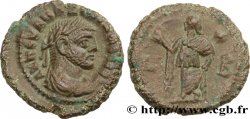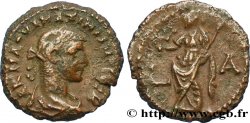brm_365454 - MAXIMIANUS HERCULIUS Aurelianus
Not available.
Item sold on our e-shop (2020)
Price : 225.00 €
Item sold on our e-shop (2020)
Price : 225.00 €
Type : Aurelianus
Date: 289-290
Mint name / Town : Pannonie Supérieure, Siscia
Metal : copper
Millesimal fineness : 50 ‰
Diameter : 23 mm
Orientation dies : 12 h.
Weight : 3,56 g.
Rarity : R1
Officine: 1re
Coments on the condition:
Exemplaire sur un flan large, bien centré des deux côtés avec les grènetis visibles. Très beau portrait inhabituel. Revers bien venu à la frappe. Patine grise avec des reflets métalliques. A conservé une partie de son brillant de frappe
Catalogue references :
Predigree :
Cet exemplaire provient de MONNAIES 34, n° 844 et de la collection Daniel Compas
Obverse
Obverse legend : IMP C M A VAL MAXIMIANVS P F AVG.
Obverse description : Tête radiée de Maximien Hercule à droite (O).
Obverse translation : "Imperator Cæsar Marcus Aurelius Valerius Maximianus Pius Felix Augustus", (L'empereur césar Marc Aurèle Valère Maximien pieux et heureux auguste).
Reverse
Reverse legend : CONSERVATOR AVGG// A|-// XXI HP.
Reverse description : Maximien et Hercule debout face à face, sacrifiant au-dessus d'un autel allumé ; Maximien est vêtu militairement ; Hercule est nu tenant la massue et la léonté.
Reverse translation : "Conservatores Augustorum", (Conservateur des augustes).
Commentary
Avec l’intégralité de son argenture superficielle. Rubans de type 1 aux extrémités bouletées. Grand buste héroïque.








 Report a mistake
Report a mistake Print the page
Print the page Share my selection
Share my selection Ask a question
Ask a question Consign / sell
Consign / sell
 Full data
Full data



